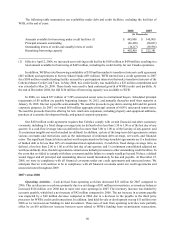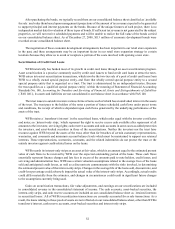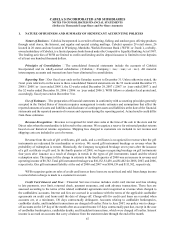Cabela's 2008 Annual Report Download - page 64
Download and view the complete annual report
Please find page 64 of the 2008 Cabela's annual report below. You can navigate through the pages in the report by either clicking on the pages listed below, or by using the keyword search tool below to find specific information within the annual report.
59
with variable interest entities. The requirements apply to transferors, sponsors, servicers, primary beneficiaries, and
holders of significant variable interests in a variable interest entity (“VIE”) or qualifying special purpose entity. The
Staff Position is effective for the first interim period or fiscal year ending after December 15, 2008, and each interim
and annual period thereafter until the effective date of the amendments to FAS 140 and Interpretation 46R, which are
still being deliberated. The new requirements include disclosure objectives as well as required specified disclosures.
The specified disclosures focus both on continuing involvement with transferred financial assets, including
involvement related to securitizations or asset-backed financing arrangements, and on a company’s involvement
with VIEs. The Company has included the required disclosures in Note 4 of our consolidated financial statements.
The adoption of FSP FAS 140-4 did not have any impact on our financial position or results of operations.
On January 12, 2009, the FASB issued FASB Staff Position No. EITF 99-20-1, Amendments to the Impairment
Guidance of EITF Issue No. 99-20. The FSP eliminates the requirement that a holder’s best estimate of cash flows
be based upon those “that a market participant” would use. Instead, the FSP requires that an other-than-temporary
impairment be recognized through earnings when it is probable that there has been an adverse change in the
holder’s estimated cash flows from the cash flows previously projected. The Staff Position is effective for the
first interim period or fiscal year ending after December 15, 2008, and each interim and annual period thereafter.
Retroactive application to a prior interim period is not permitted. The adoption of FSP EITF 99-20-1 did not have
any impact on our financial position or results of operations.
ITEM 7A. QUANTITATIVE AND QUALITATIVE DISCLOSURES ABOUT MARKET RISK
We are exposed to interest rate risk through our bank’s operations and, to a lesser extent, through our
merchandising operations. We also are exposed to foreign currency risk through our merchandising operations.
Financial Services Interest Rate Risk
Interest rate risk refers to changes in earnings or the net present value of assets and off-balance sheet positions,
less liabilities (termed “economic value of equity”) due to interest rate changes. To the extent that interest income
collected on managed credit card loans and interest expense do not respond equally to changes in interest rates, or
that rates do not change uniformly, securitization earnings and economic value of equity could be affected. Our net
interest income on managed credit card loans is affected primarily by changes in short term interest rate indices such
as LIBOR. At the end of 2008, the variable rate credit card loans were indexed to the prime rate. To mitigate our
interest rate risk, beginning January 2009, the variable rate credit loans were indexed to one month LIBOR and the
credit card portfolio was segmented into risk-based pricing tiers each with a different interest margin. Securitization
notes are indexed to LIBOR-based rates of interest and are periodically repriced. Certificates of deposit are priced
at the current prevailing market rate at the time of issuance. We manage and mitigate our interest rate sensitivity
through several techniques, but primarily by indexing the customer rates to the same index as our cost of funds.
Additional techniques we use include managing the maturity, repricing, and distribution of assets and liabilities by
issuing fixed rate securitization notes and entering into interest rate swaps.
The table below shows the mix of our credit card account balances at the years ended:
2008 2007 2006
As a percentage of total balances outstanding:
Balances carrying interest rate based upon the the national
prime lending rate 66.1%61.1%60.2%
Balances carrying an interest rate of 9.99% 1.9 3.1 3.3
Balances carrying an interest rate of 0.00% 1.3 0.3 0.1
Balances not carrying interest because their previous month’s
balance was paid in full 30.7 35.5 36.4
100.0% 100.0%100.0%
























